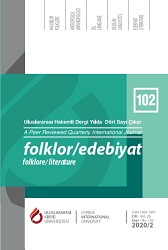The Collective Phallic Gaze, the Evil Eye and the Serpent in John Keats’ Lamia and Yashar Kemal’s To Crush the Serpent
The Collective Phallic Gaze, the Evil Eye and the Serpent in John Keats’ Lamia and Yashar Kemal’s To Crush the Serpent
Author(s): Fırat KaradaşSubject(s): Anthropology, Poetry, Comparative Study of Literature, Turkish Literature, British Literature
Published by: Uluslararası Kıbrıs Üniversitesi
Keywords: gaze; evil eye; collective; myth-making; serpent;
Summary/Abstract: The gaze is not only an act of seeing but also a collective control and oppressive mechanism used for suppressing deviations from the standard social norm. The evil gaze is the one that should be subjugated by the sacred patriarchal gaze and be pushed outside the reach of social life for the welfare of humanity. In anthropological terms, the most common emblems of the evil gaze are the evil eye and the serpent. The English Romantic poet John Keats’ Lamia, a narrative poem relating a mythological serpentine woman’s love affair with a young man named Lycius, depicts how the collective gaze operates for her destruction in the patriarchal world of Corinth, the term collective gaze being employed from Durkheim. Of particular importance is Apollonius’ gaze, which plays a crucial role in Lamia’s destruction. In Yashar Kemal’s To Crush the Serpent the aim of the gaze is crushing the serpent, that is, Esme, and most characters—especially Esme’s mother-in-law—use all the patriarchal strategies in a village setting to persuade Hasan, Esme’s son, to kill her. The article discusses the historical, religious, and mythological significance of the gaze, its collective function, and its relation to or mythical/historical enmity with the feminine within the framework of Keats’ Lamia and Yaşar Kemal’s To Crush the Serpent.
Journal: Folklor/Edebiyat
- Issue Year: 26/2020
- Issue No: 102
- Page Range: 347-359
- Page Count: 13
- Language: English

